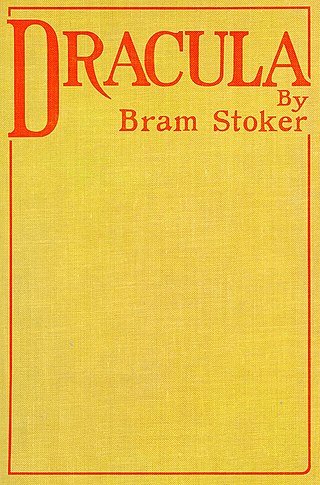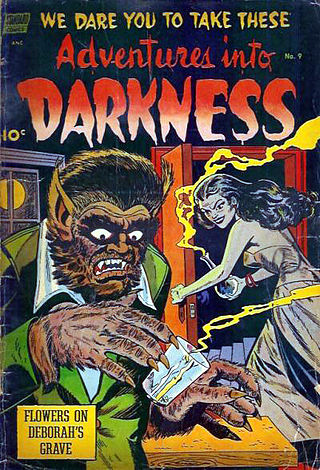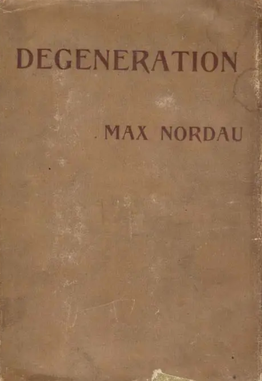Related Research Articles

Dracula is a novel by Bram Stoker, published in 1897. An epistolary novel, the narrative is related through letters, diary entries, and newspaper articles. It has no single protagonist and opens with solicitor Jonathan Harker taking a business trip to stay at the castle of a Transylvanian nobleman, Count Dracula. Harker escapes the castle after discovering that Dracula is a vampire, and the Count moves to England and plagues the seaside town of Whitby. A small group, led by Abraham Van Helsing, investigate, hunt and kill Dracula.

Gothic fiction, sometimes called Gothic horror, is a loose literary aesthetic of fear and haunting. The name refers to Gothic architecture of the European Middle Ages, which was characteristic of the settings of early Gothic novels.

Horror is a genre of fiction that is intended to disturb, frighten or scare. Horror is often divided into the sub-genres of psychological horror and supernatural horror, which are in the realm of speculative fiction. Literary historian J. A. Cuddon, in 1984, defined the horror story as "a piece of fiction in prose of variable length... which shocks, or even frightens the reader, or perhaps induces a feeling of repulsion or loathing". Horror intends to create an eerie and frightening atmosphere for the reader. Often the central menace of a work of horror fiction can be interpreted as a metaphor for larger fears of a society.

A vampire is a mythical creature that subsists by feeding on the vital essence of the living. In European folklore, vampires are undead creatures that often visited loved ones and caused mischief or deaths in the neighbourhoods which they inhabited while they were alive. They wore shrouds and were often described as bloated and of ruddy or dark countenance, markedly different from today's gaunt, pale vampire which dates from the early 19th century. Vampiric entities have been recorded in cultures around the world; the term vampire was popularized in Western Europe after reports of an 18th-century mass hysteria of a pre-existing folk belief in Southeastern and Eastern Europe that in some cases resulted in corpses being staked and people being accused of vampirism. Local variants in Southeastern Europe were also known by different names, such as shtriga in Albania, vrykolakas in Greece and strigoi in Romania, cognate to Italian 'Strega', meaning Witch.

In folklore, a werewolf, or occasionally lycanthrope is an individual who can shape-shift into a wolf, either purposely or after being placed under a curse or affliction, with the transformations occurring on the night of a full moon. Early sources for belief in this ability or affliction, called lycanthropy, are Petronius (27–66) and Gervase of Tilbury (1150–1228).

Fin de siècle is a French term meaning "end of century,” a phrase which typically encompasses both the meaning of the similar English idiom "turn of the century" and also makes reference to the closing of one era and onset of another. Without context, the term is typically used to refer to the end of the 19th century. This period was widely thought to be a period of social degeneracy, but at the same time a period of hope for a new beginning. The "spirit" of fin de siècle often refers to the cultural hallmarks that were recognized as prominent in the 1880s and 1890s, including ennui, cynicism, pessimism, and "a widespread belief that civilization leads to decadence."

She, subtitled A History of Adventure, is a novel by the English writer Sir H. Rider Haggard, published in book form in 1887 following serialisation in The Graphic magazine between October 1886 and January 1887. She was extraordinarily popular upon its release and has never been out of print.

Werewolf fiction denotes the portrayal of werewolves and other shapeshifting therianthropes, in the media of literature, drama, film, games and music. Werewolf literature includes folklore, legend, saga, fairy tales, Gothic and horror fiction, fantasy fiction and poetry. Such stories may be supernatural, symbolic or allegorical. A classic cinematic example of the theme is The Wolf Man (1941) which in later films joins with the Frankenstein Monster and Count Dracula as one of the three famous icons of modern day horror. However, werewolf fiction is an exceptionally diverse genre, with ancient folkloric roots and manifold modern re-interpretations.
Weird fiction is a subgenre of speculative fiction originating in the late 19th and early 20th centuries. Weird fiction either eschews or radically reinterprets traditional antagonists of supernatural horror fiction, such as ghosts, vampires, and werewolves. Writers on the subject of weird fiction, such as China Miéville, sometimes use "the tentacle" to represent this type of writing. The tentacle is a limb-type absent from most of the monsters of European folklore and gothic fiction, but often attached to the monstrous creatures created by weird fiction writers, such as William Hope Hodgson, M. R. James, Clark Ashton Smith, and H. P. Lovecraft.
Social degeneration was a widely influential concept at the interface of the social and biological sciences in the 18th and 19th centuries. During the 18th century, scientific thinkers including Georges-Louis Leclerc, Comte de Buffon, Johann Friedrich Blumenbach, and Immanuel Kant argued that humans shared a common origin but had degenerated over time due to differences in climate. This theory provided an explanation of where humans came from and why some people appeared differently from others. In contrast, degenerationists in the 19th century feared that civilization might be in decline and that the causes of decline lay in biological change. These ideas derived from pre-scientific concepts of heredity with Lamarckian emphasis on biological development through purpose and habit. Degeneration concepts were often associated with authoritarian political attitudes, including militarism and scientific racism, and a preoccupation with eugenics. The theory originated in racial concepts of ethnicity, recorded in the writings of such medical scientists as Johann Blumenbach and Robert Knox. From the 1850s, it became influential in psychiatry through the writings of Bénédict Morel, and in criminology with Cesare Lombroso. By the 1890s, in the work of Max Nordau and others, degeneration became a more general concept in social criticism. It also fed into the ideology of ethnic nationalism, attracting, among others, Maurice Barrès, Charles Maurras and the Action Française. Alexis Carrel, a French Nobel Laureate in Medicine, cited national degeneration as a rationale for a eugenics programme in collaborationist Vichy France.
Dark fantasy is a subgenre of fantasy literary, artistic, and cinematic works that incorporate disturbing and frightening themes. It often combines fantasy with elements of horror, possessing a dark and gloomy tone or an atmosphere of horror and dread.

"The Outsider" is a short story by American horror writer H. P. Lovecraft. Written between March and August 1921, it was first published in Weird Tales, April 1926. In this work, a mysterious individual who has been living alone in a castle for as long as he can remember decides to break free in search of human contact and light. "The Outsider" is one of Lovecraft's most commonly reprinted works and is also one of the most popular stories ever to be published in Weird Tales.

Erotic horror, alternately called horror erotica or dark erotica, is a term applied to works of fiction in which sensual or sexual imagery are blended with horrific overtones or story elements for the sake of sexual titillation. Horror fiction of this type is most common in literature and film. Erotic horror films are a cornerstone of Spanish and French horror.
Minority is a philosophical concept developed by Gilles Deleuze and Félix Guattari in their books Kafka: Towards a Minor Literature (1975), A Thousand Plateaus (1980), and elsewhere. In these texts, they criticize the concept of "majority". For Deleuze and Guattari, "becoming-minor(itarian)" is primarily an ethical action, one of the becomings one is affected by when avoiding "becoming-fascist". They argued further that the concept of a "people", when invoked by subordinate groups or those aligned with them, always refers to a minority, whatever its numerical power might be.

The Werewolf of Paris (1933) is a horror novel as well as a work of historical fiction by American writer Guy Endore. The novel follows Bertrand Caillet, the eponymous werewolf, throughout the tumultuous events of the Franco-Prussian War and the Paris Commune of 1870–71. Some literature experts have compared this book with Dracula of Bram Stoker and they have indentified it as the Dracula of Werewolves.

LGBT themes in horror fiction refers to sexuality in horror fiction that can often focus on LGBTQ+ characters and themes within various forms of media. It may deal with characters who are coded as or who are openly LGBTQ+, or it may deal with themes or plots that are specific to gender and sexual minorities.

Degeneration is a two-volume work of social criticism by Max Nordau.
American gothic fiction is a subgenre of gothic fiction. Elements specific to American Gothic include: rationality versus the irrational, puritanism, guilt, the uncanny, ab-humans, ghosts, and monsters.

Urban Gothic is a sub-genre of Gothic fiction, film horror, and television dealing with industrial and post-industrial urban society. It was pioneered in the mid-19th century in Britain, Ireland, and the United States, before being developed in British novels such as Robert Louis Stevenson's Strange Case of Dr Jekyll and Mr Hyde (1886) and Irish novels such as Oscar Wilde's The Picture of Dorian Gray (1890) and Bram Stoker's Dracula (1897). In the twentieth century, urban Gothic influenced the creation of the sub-genres of Southern Gothic and suburban Gothic. From the 1980s, interest in the urban Gothic was revived with books like Anne Rice's Vampire Chronicles and a number of graphic novels that drew on dark city landscapes, leading to adaptations in film including Batman (1989), The Crow (1994) and From Hell (2001), as well as influencing films like Seven (1995).

The Blood of the Vampire is a Gothic novel by Florence Marryat, published in 1897. The protagonist, Harriet Brandt, is a mixed-race psychic vampire who kills unintentionally. The novel follows Harriet after she leaves a Jamaican convent for Europe, and her ill-fated attempts to integrate with Victorian society.
References
- ↑ Valier, Claire (2004). Crime and Punishment in Contemporary Culture. London: Routledge. p. 121. ISBN 0-415-28175-X.
- ↑ Hurley, Kelly (1996). The Gothic Body: Sexuality, Materialism, and Degeneration at the Fin de Siècle. Cambridge: Cambridge University Press. p. 168. doi:10.1017/CBO9780511519161.010.
- ↑ Luckhurst, Roger (2002). The Invention of Telepathy: 1870–1901. Oxford: Oxford University Press. p. 188. ISBN 0-19-924962-8.
- 1 2 Hogle, Jerrold E., ed. (2002). The Cambridge Companion to Gothic Fiction. Cambridge: Cambridge University Press. p. 190. ISBN 0-521-79466-8.
- ↑ Day, Peter, ed. (2006). Vampires: Myths and Metaphors of Enduring Evil. Amsterdam: Rodopi. p. 22. ISBN 9-0420-1669-8.
- ↑ Bourgault du Coudray, Chantal (2006). The Curse of the Werewolf: Fantasy, Horror and the Beast Within. London: I.B. Tauris. p. 132. ISBN 1-84511-158-3.
- ↑ Hurley, Kelly (1996). The Gothic Body: Sexuality, Materialism, and Degeneration at the Fin de Siècle. Cambridge: Cambridge University Press. p. 3. doi:10.1017/CBO9780511519161.001. This quotation also appears in Eaglestone, Robert (2006). Reading The Lord of the Rings: New Writings on Tolkien's Classic. London: Continuum International Publishing Group. p. 55. ISBN 0-8264-8459-X.
- ↑ Lloyd-Smith, Allan (2004). American Gothic Fiction: An Introduction. New York: Continuum International Publishing Group. p. 114. ISBN 0-8264-1594-6.